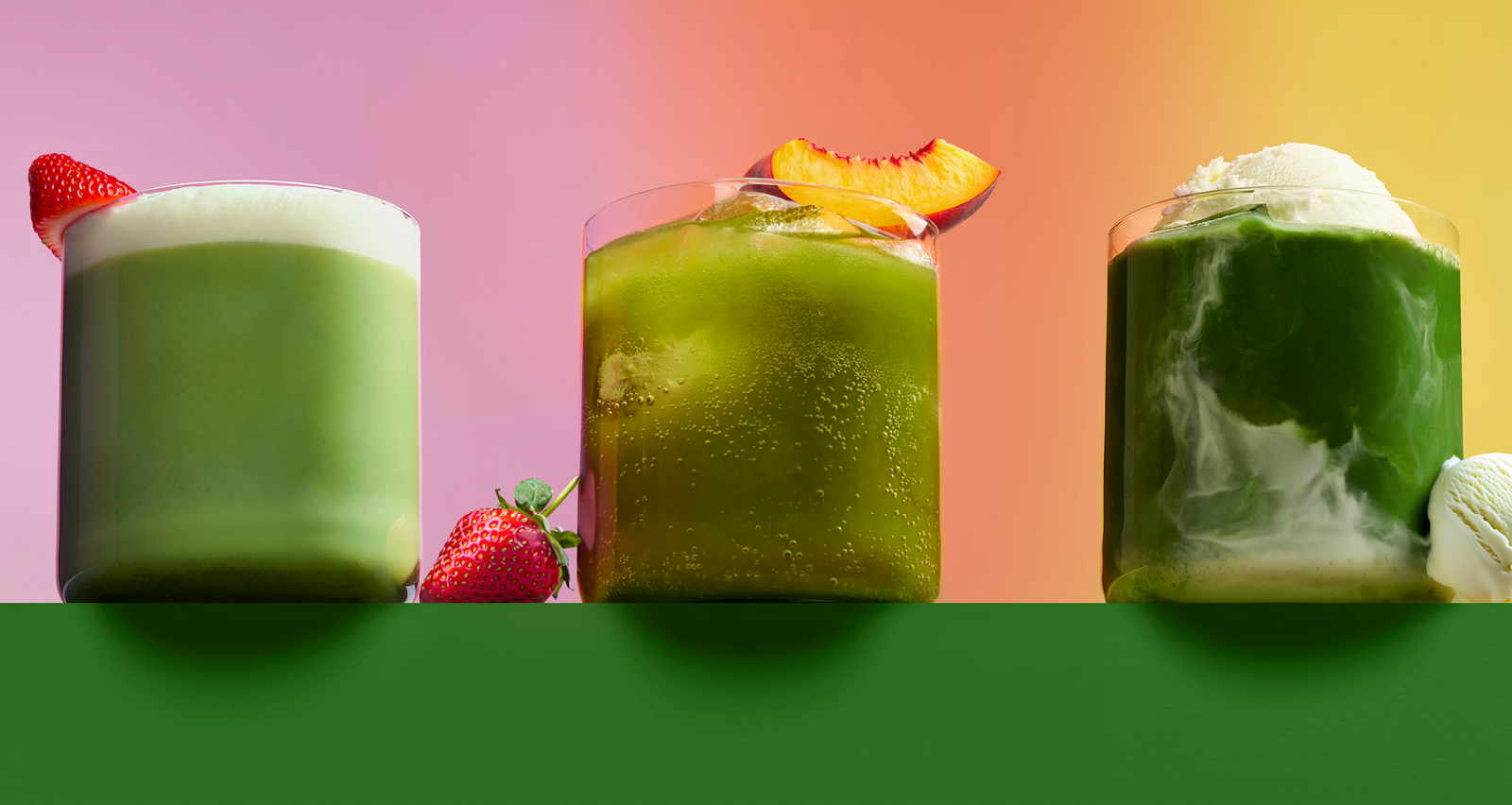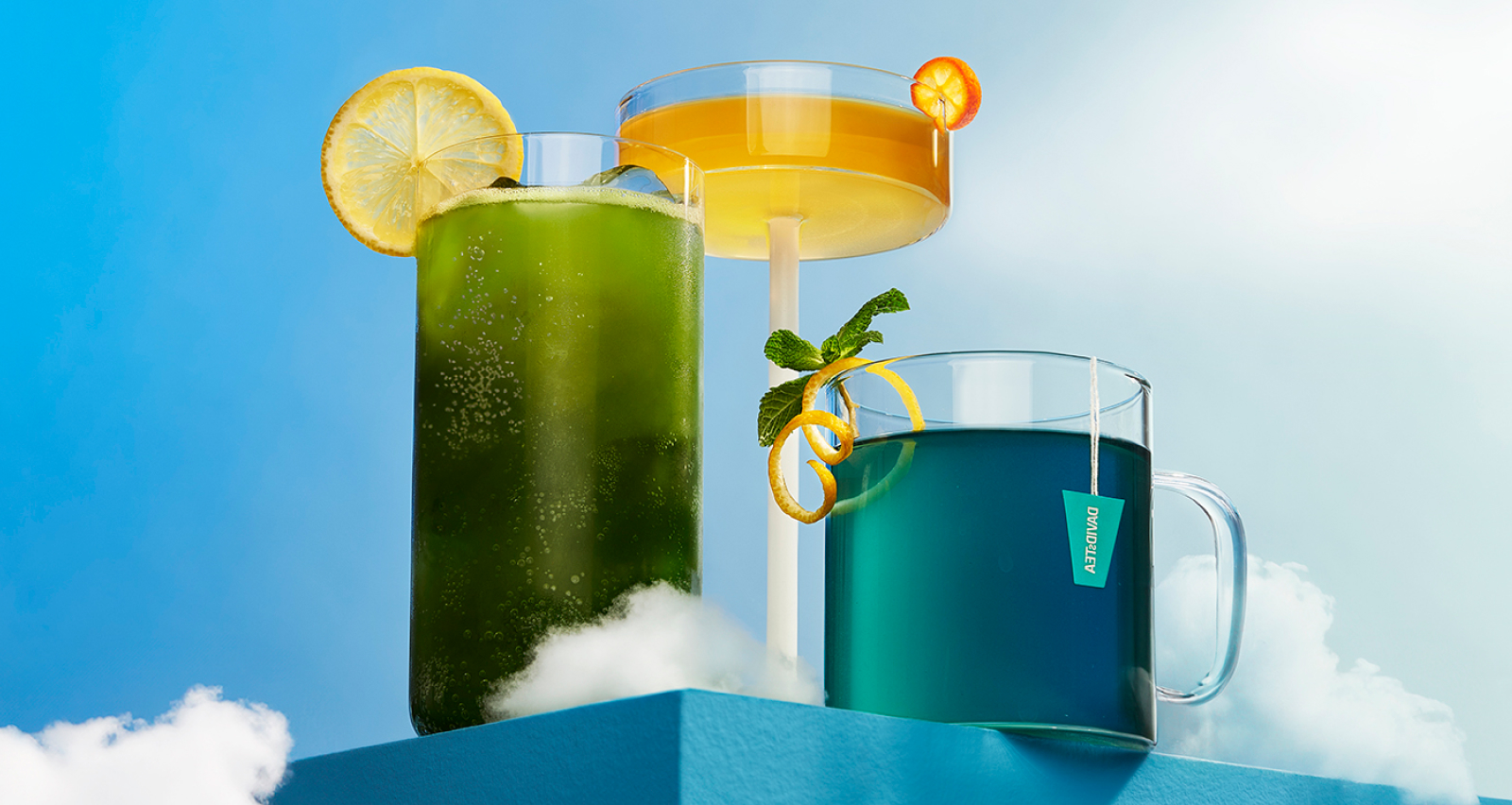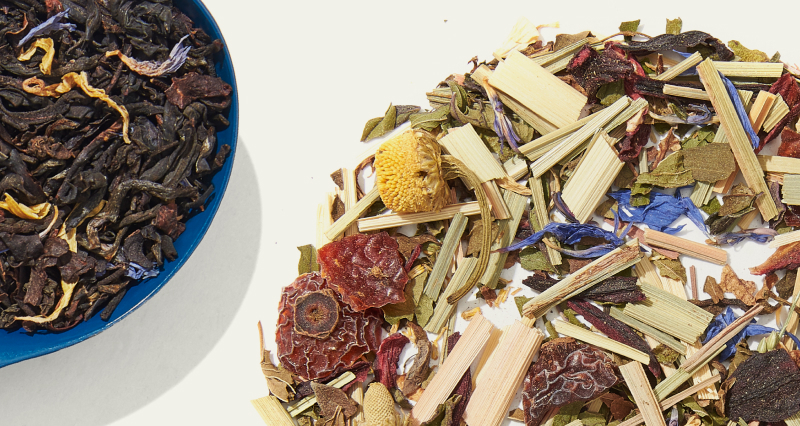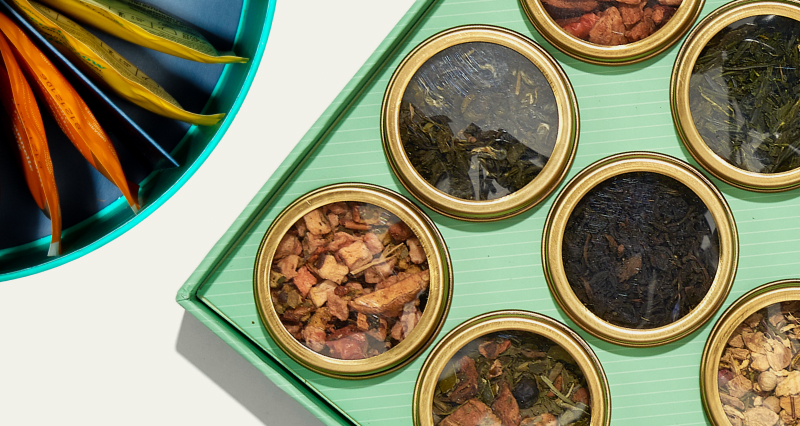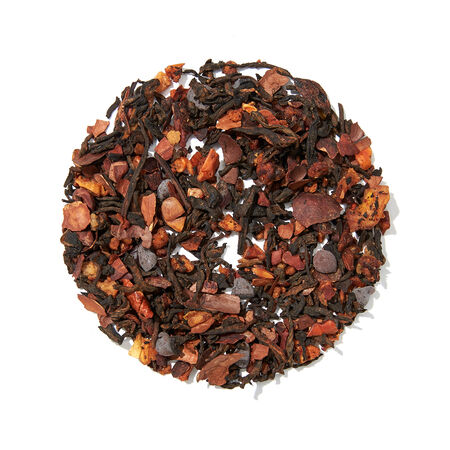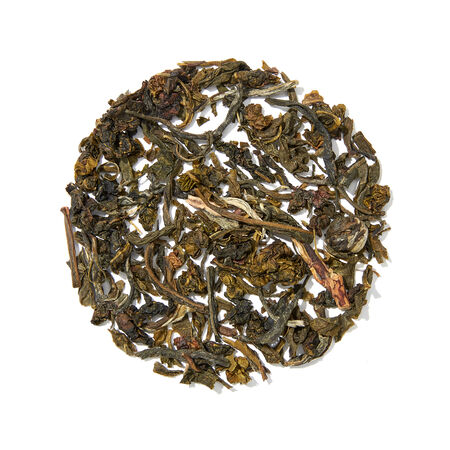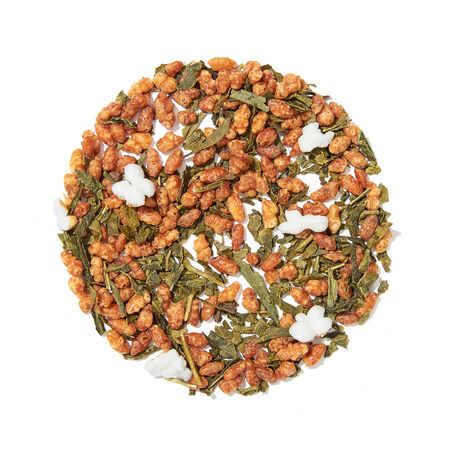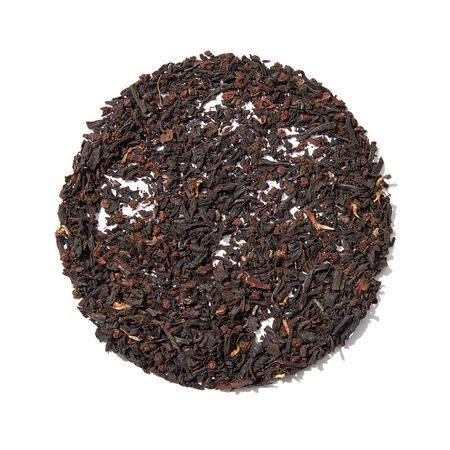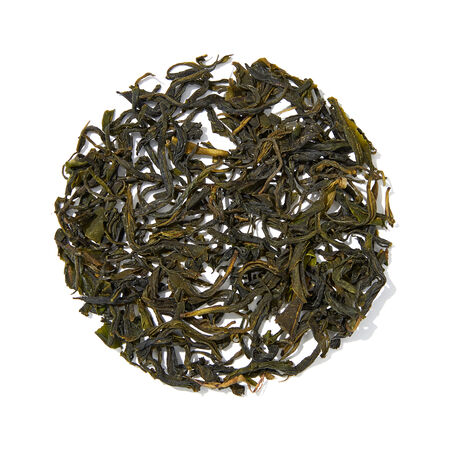episode 5
How do you
create a tea?
with Billy Dietz

steeping together
podcast - episode #05
How do you create a tea?
with Billy Dietz
episode transcript
Marika de Vienne 0:21
Welcome, everyone to another episode of Steeping Together, the podcast where we explore the vast world of tea over a cup of tea with tea enthusiasts. I'm your tea-obsessed host Marika, and I'm so excited to be here today with you all. So nature has provided us with so many amazing plants and herbs, our favourite being the Camellia sinensis plant. With careful manipulation through various drying, oxidation, and storage methods, this one plant can provide a myriad array of flavours both soothing and tantalising. But how does one create a tea that tastes like key lime pie or roasted marshmallow? And if you're asking yourself why would I want a tea that tastes like key lime pie or roasted marshmallow? Well, then to that I say, what – are you allergic to fun!? Look, traditional teas can encapsulate many notes that we can free associate with different flavours but how do you create a tea that is in and of itself a recreation of a culinary dish? In an effort to answer this question, I have enlisted the help of our resident expert on flavour balance and creation Billy Dietz. Billy, welcome to Steeping Together!
Billy Dietz 1:30
Thanks, it's so nice to be here with you, Marika!
Marika de Vienne 1:32
Billy, would you care to introduce yourself the way you would like to be introduced?
Billy Dietz 1:36
My name is Billy Dietz. I develop creative products and hope that the world enjoys them.
Marika de Vienne 1:45
That is so beautiful. Oh my god, sorry, I'm really taken aback by that. You hope that the world enjoys them. I know you because we've been working together for the past three years and I know that you deliberately seek out different flavours from all kinds of inspirations, be it desserts, be it you know, savoury dishes, but there is a joy that you bring to that research that I really appreciate. And I think I just put it together, that that joy stems from wanting to bring others joy.
Billy Dietz 2:15
Of course, that's what it's all about! When it comes down to it, that's what tea is about. It's about helping to bridge those conversations over a cup of tea, or whether that's bringing friends together. Or whether that's bridging and making a connection to someone of a different culture, that's really what it comes down to.
Marika de Vienne 2:38
I love it. I'm gonna say that a lot. I say that a lot. I love it. But I love that kind of warmth and joy that you bring to your job because you are the Director or the head of R&D here at DAVIDsTEA. Like what does that mean?
Billy Dietz 2:53
There's a lot of different meanings and I think a lot of different ways where you can interpret it because while yes, it's just like any other job, it has its administrative side, it has the things that you normally need to do with any job, right. But I think one of the differences with this job is inherently, you do, as a person that's doing developing, you do need an inherent and deep personal passion for flavour in every form. Whether that's in other beverages, whether that's in your cooking and foods and things that you seek out to eat, and flavours that you wish to discover. It's a job that you can't really turn off, so I think there does need to be an inherent and deep-seated passion for that. So even cooking – my partner and I we cook at least twice a day.
Marika de Vienne 3:46
Yes, I have seen your Instagram feed!
Billy Dietz 3:49
Mostly hers.
Marika de Vienne 3:52
Mostly hers, yes! But yeah, this isn't something that you walk into the office at nine, turn on, and then leave at five and turn off. I think it is a commonality with a lot of people who work at DAVIDsTEA, is that kind of flavour-hunter aspect that need to discover and you know, expand on flavour and learn more about it and to see how it connects us all and makes us all very, very human, you know, the need to cook our food and to transform what sustains us into something delicious that everyone can share and appreciate. I think that's something that we – not all of us in the office, I mean some people work in finance and I'm not putting anything on the people in finance. The good people of finance I'm sure enjoy a good a good meal. But I think certainly in the tea department that seems to be kind of the running thread. We're all very distinct people we have distinct cultural, socio-economic, geographical, cultural backgrounds. But I think at the very heart of it, we have a passion for flavour and sharing that passion.
Billy Dietz 4:58
Yeah, no, I totally agree. And when it comes down to it, tea is just fun and transmitting different flavours through tea is just fun!
Marika de Vienne 5:08
I know, it sounds so silly but when something is fun it propels you to keep going and to keep discovering and keep tasting! Absolutely wonderful. So, when we are talking about R&D-ing a tea, so nature has provided us, as I said at the introduction of this episode, with the plant, the Camellia sinensis plant, that if you oxidise to 10%, to 20%, to 30%, 70%, you're going to get different flavours. That's how you get, you know, the distinction between green, white and pu’erh and all of that. Why would we as a species, need to flavour a tea if we already have the perfect plant there? I mean, we've been doing it for hundreds of years, right? I mean, the very first teas were pu’erh teas, so they're not oxidised, they're fermented. And I don't know, have you ever heard the history of like the first pu’erh cakes from like 5000 years ago?
Billy Dietz 6:10
Maybe in different forms, but let's go over it.
Marika de Vienne 6:13
Well I mean, what I read – and you'll tell me if I'm wrong or not – I've read that these cakes, yes, had tea, but they also had other ingredients in them, and ingredients as varied as orange peels and onions and salt. It's almost like the progenitor, the origin of tea was closer to a soup than it was to a singular beverage.
Billy Dietz 6:35
So that's what I've heard, is that the tea, and in particular compressed tea, was an easy means of transporting different nourishment to populations that were maybe in more arid climates or higher elevation climates that didn't have the right climates to grow vegetables and other nutritious things. And the way to overcome the inherent bitterness, let's be honest of Camellia sinensis was to put these other sweet ingredients or fragrant ingredients. And salt in particular, salt is a binder to bitterness as a taste receptor. So it helps to curb that.
Marika de Vienne 7:22
You just dropped a bomb oh so casually, you said salt is a binder to bitterness? What do you mean by a binder?
Billy Dietz 7:30
Meaning that, to keep it simple, adding salt to your food reduces the bitterness of that food. That's why, let's say blanched vegetables, if you blanch them in salted water, are less bitter than their fresh counterparts.
Marika de Vienne 7:45
Okay, so these cakes were made partially in need for greater sustenance than just tea leaves and the human instinct to make something taste better goes back thousands of years, it's just so deeply ingrained in our brains. And just the way we see the world, we don't eat raw meat, you know, we have to season it, we have to cook it, we have to poach it or blanch it or fry it or we have to change it. And so this is a conversation I've had with a lot of tea-centric people who have a tendency to stay on the side of traditional teas, of what we've now come to know as traditional teas. Unadulterated aside from the oxidation process or the drying process. And my argument to that is always well, first of all, you do you. Is that what you like? Do that, I'm not here to convince you otherwise! But I will add a few comments, which is that, as humans, we've always flavoured our most basic dishes, our most basic teas, and I can think off the top of my head of a few dozen teas that are have been flavoured for hundreds of years. The one that I'm going to pull out right now is genmaicha.
Billy: Great example.
Marika: So I've heard a few origin stories for genmaicha, some are fanciful, some are, they lack credibility, shall we say. But genmaicha is a Japanese steamed green tea to which roasted rice is added. Now from a historical perspective, this innovation happened at a time where Japan was going through civil feudal wars, and one theory is that they added the old popped rice to the tea in order to just sustain themselves a little bit more, which goes back to your earlier point. I've also heard the amazing myth that this was created by a samurai’s servant, who accidentally dropped some rice in a tea pot and his master was so offended that he chopped his head off upon drinking the tea, and then decided to drink the tea and realise that it was very good and named the tea after his now dead servant. I mean this tea has taken on – I think anytime you have a samurai involved in an origin story, it's pretty intense, right? But from a culinary perspective, from a flavour-balance perspective, why would one add roasted rice to a green tea? Like, what are the elements that we're balancing out here?
Billy Dietz 10:17
Well in a Japanese sencha, or probably more likely a buncha, in this case. You have a cooked steamed vegetable quality that is fresh, whereas the toasted rice is going to bring sweetness because of the process of it being toasted, as well as that roasted note, which helps to balance out those more vegetal components. So I think inherently, it's a balance of contrast, rather than of complementary flavours.
Marika de Vienne 10:53
Right, and that's what has sustained this. I mean, this tea was invented sometime in the 1600s, we're assuming. And it's one of the world's OG flavoured teas, you know, and it's now considered traditional like for traditional tea drinkers, it's part of the tea pantry that they go to. So to me, you know, the divide between flavoured tea and straight tea, lool there will always be debates, and I'm always open for a good debate as long as it's over a cup of tea. But you work primarily in the engineering, the ideation, the I don't know, the spit-balling of the creation of new teas here at DAVIDsTEA. How do you even start, this is my big question, like, where do you start? Billy, what do you what do you look at? Do you wake up in the morning, put a bunch of black tea leaves on your table, do a kind of oracle manifestation of like, what would be good on you? Like this is how I see your job, I’m imagining like incense burning, and you're like, “Tell me leaves, what would you like me to put on you?”
Billy Dietz 12:08
First of all, I love that and maybe we're gonna use that and recreate that in a good creative session here at the office because that sounds like a blast. But I think there are a few ways to go about it. But I will stick with the most like, organically creative method for ideation of a tea blend. And what that is, is starting at the end, instead of starting at the beginning, and you work your way backwards. So the way at least that I would picture it, as I don't know, if I'm scrolling through recipes, on the internet or in a magazine or anything else. And I stumbled on something that – oh this is not typical. This is something that we haven't done before, that we've not tried before. Well, what is the final thing? So a good example would be something like a, I don't know, banana crème brulée.
Marika de Vienne 13:11
Okay, let's go with it.
Billy Dietz 13:14
So go online, look at banana crème brulée. What are the components. Very broad strokes, what are the components of that in terms of flavour? What are the components of that in texture? And then going beyond that, what components do you want in the end cup and at what balance. So you could have the banana crème brulée as your ideation, but someone might say, “Ooh I want the banana and the burnt sugar to come out the most” Whereas someone else might say, “Oh, I want the banana and the vanilla, like cream and custard flavours more associated with crème brulée.” So I think that the first distinction is coming up with your final descriptor and what you want and then work backwards.
Marika de Vienne 14:03
Okay so let's take this example of banana crème brulée, which I love because crème brulée is my favourite dessert of all time. And I've never thought of putting bananas in it. But as soon as you said it, I was like, yeah, that works. I wouldn't be offended if someone handed this to me. You'd have the banana, it’s not a zesty fruit, you know, it's a nice soft sweetness. I think the texture of the banana would play very, very well with the cream. Am I subtly trying to invite myself over to your house so you can make this for me? Maybe. Not the point, let's keep going. So you're gonna say, I want it to be… I'm going to tell you Billy, I want it to be lightly sweet. I want the banana to come out, but even though I said lightly sweet, I'm probably going to want some burnt sugar aspect in there. And to me the glory of crème brulée comes in the texture of the cream. And yes, it's the dichotomy between the crust on the top and the cream on the bottom, but what I'm really looking for is that comfort, that cream, that vanilla to come in.
Billy: The silk.
Marika: Oh that's the word, there we go! Le mot juste! The silk, exactly! That's what I'm looking for. How have I been eating this for 39 years, and you finally just like randomly pull out the perfect descriptor for what I've been feeling this whole time. This is why you're the head of R&D! Yes, the silk. This is what I want you to create for me. Go, run with it. What are you doing? Like, are you – My next assumption is that you're going to go for the base, because you're gonna need a tea base. And caveat, I want it caffeinated, I am a mother of two, I do not have time, I need energy, I gotta go. How do you determine the base at that point?
Billy Dietz 15:55
So the base of a tea, and there are, as many people know, hundreds and hundreds of different bases you can choose from even within just one tea type, right?
Marika de Vienne 16:07
Yeah like even within black teas. If I said black tea, you would have 300 options off the bat.
Billy Dietz 16:13
Exactly. So that's the first thing to note, is okay well you want a tea base, just going off the cuff, I would go for either an oolong or a black tea. Those would probably be instinctively the first choices that I would go if you want to accentuate that nice burnt sugar quality, but also make sure that you have this like sweet and silky vibe. Those I think would be both good options. I think the oolong, using a certain oolong would probably help better in that silky custardy texture that we want to achieve.
Marika de Vienne 16:53
I'm assuming a greener ooong, because, I love how you were like “certain oolongs,” you added that at the last minute. Would you go with a greener oolong like a Tie Kwan Yin, like a Si Ji Chun or something more in the middle?
Billy Dietz 17:08
Yeah I think it would need to be something in the middle, so you'd want a little bit of oxidation because it helps bring those like golden flavour notes. And by golden I mean the burnt sugar, the maillard, those type flavours. So that is what would be probably exciting to me. With black tea, maybe it's a little bit more thinking, not about the flavour of the actual tea base, but what the tea base is bringing. So if you want silky, you want to stray away from adding astringency because astringency will cut that texture that you're looking for. So these are just a few of the things that are going on in my brain and the brains of the talented people on my team and that we work with here. That's the way that we're viewing these products. Is to create a complete, layered, final product.
Marika de Vienne 17:59
Yeah, no, it makes sense. And it makes sense that, I mean, you mentioned your team because it's not just you, you're not alone in a room just coming up with these flavour creations. It does sound like it's something that needs a lot of conversation, a lot of back and forth with different people to gain perspective on what you would want this final product be. So their input is invaluable. Like you literally – could you do your job without that input?
Billy Dietz 18:27
You can't do this job alone.
Marika de Vienne 18:31
Yeah, well, fantastic. Fortunately you're not alone! And we all have our opinions on what we would want banana crème brulée to taste like in the end. Okay, so you have all these different conversations, you have all these different perspectives, you have all these different ideas. It reaffirms in my mind that the title “Research and Development” is a really cold one for a department that has so much warmth and so much interaction and so much creativity. So what's the creative part of your job that you enjoy the most?
Billy Dietz 19:08
Experimentation, trial and error always drives you to learn more and there is no shortage of learning. And I think for me, the creative outlet kind of comes in the form of continued learning because there is no point at which we are going to reach a cap on what we can do with blended tea. And that is exciting!
Marika de Vienne 19:40
Your eyes literally lit up, like that is exciting! I completely agree with you because you will continue to be inspired by, yes trends but more other creatives in the sense of you know, chefs or bloggers or other flavour hunters. I mean, we're not alone. And you can continue to get pushed to that limit of creating something new. What was the hardest tea for you to nail? You know that you nailed, like you know you succeeded at it?
Billy Dietz 20:16
Wow. One of one of the journeys in development that I think took a lot of not only creative effort, but just fine tuning, was creating a hazelnut-chocolate tea. Because there is a certain association that everyone has with hazelnut-chocolate spread.
Marika de Vienne 20:40
It rhymes with “fu-tella.”
Billy Dietz 20:42
Exactly!
Marika de Vienne 20:45
We can't say it. But there it is.
Billy Dietz 20:48
So this association is sort of the pinnacle of flavour that is ubiquitous as the – where you need to hit. It's your benchmark, it is your goal. In texture, in composition of flavour, in balance, the cocoa with the toasted hazelnut, all of these things have to come together. Not only perfectly but like beyond perfectly. And I say that not out of frustration, I say that because it continues to push and make you better, and make your products better, and your partners and your team better. So that's all good. But this particular profile has been worked on in renditions for, even before I joined DAVIDsTEA, which now is over six years. So this has been going on in the background for a long time.
Marika de Vienne 21:48
And we're talking about, this is not just conversations. This is creating samples, tasting samples, talking through those samples, what went right, what went wrong, because to hit that flavour that as a western audience that we know so well, that we've had since we were children, everybody has their own memory of this flavour. Everybody can recall that flavour almost instantly the minute you say the word. So over six years to develop it. When did you know we got it, we did it, like we can rest?
Billy Dietz 22:31
I think the biggest game changer for us as a development team was twofold. One was finding the proper sweetener to use to help accentuate that sweetness of the chocolate. But the other game changer was finding the right pu’erh base. That pu’erh base turned out to be just so perfect to capture both the nutty quality and like the deep rich flavour from the chocolate. That for me, that's what made it.
Marika de Vienne 23:18
Because yeah, I always try to put on, not put on, but I always try to taste the teas that the R&D team presents with a great deal of you know, optimism and objectivity. And when I first saw the tea and the tea base, I thought, “good Lord in heaven, what have they done to one of the most ancient teas on the planet? What would possess them?” And then I tasted it, and I understood immediately what had happened. That tea, you genuinely taste the hazelnut, the chocolate, it's not overly sweet. Yes, you can turn it into a latte. Yes, it makes a phenomenal iced latte, by the way, like holy cow that is nice and smooth. But it didn't betray the base. And by that I meant I can still taste the pu’erh but the pu’erh is accentuated by these additions. And to me that was, I agree with you. It took a really long time to come up with. I really think you nailed it with that one. If I didn't think that I probably would have just gone, “yeah, well good for you. I'm happy you were happy with that result.” But it is one of my favourite teas. It is just a really beautiful tea. So Billy, in wrapping up here, what does tea mean to you? When I say tea, what does it evoke?
Billy Dietz 24:45
This is going to be maybe ironic coming to you as an American. But tea, there's a lot of freedom in tea. There is freedom for the processors to experiment, try different things. There is freedom for companies and wholesalers and whatever to blend and to try out different flavours and there is freedom for the end consumer to brew it however they want it. And I feel like with a lot of other products they're already given to you complete. Wine is given to you complete, beer, same thing. Even coffee, yes there are different methods but unless you're roasting yourself, you don't even control that. With tea you have an unbridled scope of freedom in what you can do with it and make it how you want.
Marika de Vienne 25:48
Right, I can’t – first of all, I completely agree with you, like 100%. Being married to an American myself, am I shocked that the thing that tea means to you is freedom? No, no, I'm not. But I do love how you expressed it because yeah, it is absolute freedom. Alright, so before we go and take a break, I think I'm going to take a break with this tea you’ve brought today. So you want to tell everyone what we've been sipping on this whole time?
Billy Dietz 26:20
Indeed, we are sipping on Guangzhou Milk Oolong. Again, one of these OG flavoured teas. The flavouring in which most commercial milk oolongs are made now was added in order to accentuate a natural property of the terroir where this particular varietal was grown. So there's a sense of tradition even in a flavoured milk oolong.
Marika de Vienne 26:49
Absolutely no, I love milk oolongs, I love Jinchuan which is the traditional tea upon which it's based, and before the flavouring was added one of the tasting notes or describers associated with this tea was its creaminess and through innovation and modern flavouring techniques, milk flavouring was added, and it's another one of those examples where we're not hiding the tea with the flavouring, we're accentuating what's already there and pushing it to its next logical step, which I really love. It's been perfect for this conversation. Thank you so much for bringing it and we're going to take a little break and enjoy our tea.
AD BREAK 27:30
Today's episode of Steeping Together is brought to you by Organic Emerald Jade. Organic Emerald Jade is plucked from a family-owned organic tea garden in Suizhou prefecture, China. This classic Chinese green tea is fresh, energizing and super easy to drink. And our Director of R&D, Billy, literally drinks it every single day. No joke, the man has access to literally thousands of teas and yet every time I see him at work, that's what he's drinking! So, Organic Emerald Jade. Look if it's good enough for a head of R&D, it’s good enough for you.
Marika de Vienne 28:09
Welcome back, it's time to play “What Are You Drinking?” The quiz where we ask our guests three situational questions, some realistic, some completely out there. And they have to use all their experience and expertise to tell us what they would drink in any one of these given situations. Billy, are you ready to play “What Are You Drinking?”
Billy Dietz 28:28
Let's do this.
Marika de Vienne 28:30
Billy, it's pizza night. You've ordered in a pizza with all your favourite toppings. And now you just need the perfect tea to go with it. What are you drinking?
Billy Dietz 28:40
Ooh, honestly, that is super easy.
Unknown Speaker 28:45
I like how you’re judging. You thought it was gonna be way harder than that! You're like, “Oh, you're gonna lob an easy one at me? Fine, Marika.” Alright, I'll make them harder. Noted.
Unknown Speaker 28:59
Pizza night. Iced Orange Pekoe. Slice of lemon. Little bit of sugar.
Marika de Vienne 29:05
Oh, I'm excited! I wanna – oh – sorry, that is classic!
Billy Dietz 29:12
American.
Marika de Vienne 29:13
Yeah I know. I didn't want to say it, I didn’t wanna be like, “Well obviously it’s gonna be an iced tea.” But yeah, there's a reason that's just a good old classic, right? You've got some astringency. You've got that refreshingness. It kind of doesn't matter at that point, or does it, what toppings you had on your pizza?
Billy Dietz 29:32
You know, I don't think it matters as much because the pizza regardless is going to be salty and fatty, and having some sweetness and a little bit of acidity and astringency to balance that out, that's all you need.
Marika de Vienne 29:47
Perfect. Excellent. All right, ready for question two?
Billy: Bring it on.
Marika: Things are starting to get serious with your significant other and you're about to meet their parents for the first time. You're hosting them for tea and brunch, what tea do you pick to impress them? And how do you brew it? What are you drinking?Billy Dietz 30:07
Oh, my.
Marika de Vienne 30:09
Little harder, huh?
Billy Dietz 30:11
It is a little bit harder. You know what? I feel like I'm going to go not with my gut instinct on this. I'm doing a blooming tea in a glass teapot.
Marika de Vienne 30:25
Okay, wait, wait wait wait, okay. You're not going with your instinct. We need to unpack that first. What was your first instinct?
Billy Dietz 30:33
My first instinct was probably to do, like gongfu-style oolong. Because that’s just what I'm the most comfortable with, it's what I prefer, it’s what I like. But that's thinking about me.
Marika de Vienne 30:46
Very smart. Because you don't want it to be all about you when you're meeting the significant others parents for the first time, you could be seen as egotistical. And they would share that with your partner.
Billy Dietz 30:59
And already as an American…no!
Unknown Speaker 31:05
You’ve had so many strikes against you, why are you adding even more? No, completely untrue. Okay, I like the pivot. I like the self awareness of the pivot, quite frankly. And then you're going to go for a blooming tea. Okay so for anybody who doesn't know, blooming teas are handsewn tea leaves that are compressed into balls. And so when you put them in a clear tea pot and add hot water, they literally bloom into a flower, and it's visually stunning. This is what you're going with, for what reason?
Billy Dietz 31:36
Making something else the focal point.
Marika de Vienne 31:40
Oh you're Machiavellian in your introduction to the significant others parents, I enjoy this. Making something else the focal point, you're like Houdini-ing them!
Billy: Sounds so deceitful!
Marika: You have one shot, you have one opportunity to make an impression with these people and you're taking it. And you know what? I respect it!
Billy Dietz 32:01
Blooming tea it is.
Marika de Vienne 32:03
Okay, making a conversation piece. That's the nicer way of saying it. You're not trying to distract or deceive, it's a conversation starter, it's a conversation piece. Excellent. Well done, Billy, 30 points. I'm just assigning points for because I feel like you gave a lot of thought to that and I feel like you need some kind of like cookie or something. So there you go, you’re welcome!
Billy Dietz 32:27
Oh thank you, love my blue star.
Marika de Vienne 32:31
Alright, last question. You're a caterer and you’ve just been hired to provide the food and beverage for the opening reception of a very high profile artist. The exhibition features hundreds of meticulously painted portraits of ostriches working customer service jobs. The artist wants the tea that’s served to be on theme with this collection of ostrich artwork. What are you drinking?
Billy Dietz 32:58
That is a lot to unpack.
Marika de Vienne 32:59
It's a lot. First of all, this is high profile. This is Musée des beaux-arts. This is, you know, the Met, you know, this is a real exhibition. So you can't laugh at the art. First step, right. This is a profound statement on the state of customer service in the 21st century. How are you embodying that in a tea?
Billy Dietz 33:27
Maybe the easiest way for me to wrap my head around this is to find the things that are relatable within tea. So ostriches, I think Africa, so then I think African tea. There is bountiful, and wonderful teas. But then I think high profile. So I'm gonna go out and try and find a pretty exclusive, like silver needle-style tea, but with African origin.
Marika de Vienne 34:03
Like a Kenyan white?
Billy Dietz 34:05
Exactly.
Marika de Vienne 34:08
Oh and the white leaves, which are very, you know, feathered, and have, you know, little hairs, birdlike almost.
Billy Dietz 34:18
Birdlike, I think that that would be my angle.
Marika de Vienne 34:21
I'm always so impressed at how you're able to, like, take the different components of something and put it together. And I think that's why you're the head of R&D. I mean, you have a lot of professional background, you have a great skill set, you know, but you have an ability – you took that question, and you took all of its components, and you really took something that was already out there and made it your answer. I love that so much. I have no follow up because that is the final say on the most bizarre question we've had yet on “What Are You Drinking?” Billy, bravo! You win!
Billy Dietz 35:03
30 points, a blue star, and I win? This couldn’t be better!
Marika de Vienne 35:10
Oh my gosh, Billy, I cannot thank you enough for joining me today in this conversation. It has been enlightening. It has been just fascinating. Thank you for taking the time to share your knowledge and passion with us.
Billy Dietz 35:21
Thank you and I hope everyone can look at blended tea in a very different light, maybe something you haven't thought of before. Because it is a world that is wild and crazy and embracing that wild and crazy might do us all some good.
Marika de Vienne 35:38
I could not have said it better myself, thank you so much. And thank you for listening to today's episode. If you would like to reach us with comments, questions, or suggestions for the “What Are You Drinking?” game you can do so at steeping.together@davidstea.com or through our website davidstea.com. Have a great week and happy steeping everyone.
Billy Dietz

about the guest
Billy’s journey into the tea world began at the early age of 15, when he started his formal education at the Specialty Tea Institute. By 17, he became the youngest Certified Tea Specialist in North America (yes, you read that right!). He went on to study at FONA International, where he completed Flavor 101 and Beverage 101 – two comprehensive courses on the science of flavor, and more specifically, beverage flavor. In August 2013, he obtained his Barista certification from the Specialty Coffee Association of Europe at the Bettr Barista Academy in Singapore. And by 2014, he became a certified instructor for the Specialty Tea Institute. But if there’s one thing you need to know about Billy, it’s that he has quite the adventurous spirit. His passion for flavor has taken him to many parts of North America, Europe, Asia and Africa where he studied how beverages and food are integral to each of their cultures. In 2015, Billy joined the DAVIDsTEA family as a Tea Products Developer. Today, he’s the Director of Research and Development. What exactly does that entail? Well, Billy works closely with our Tea Department to research, develop and create innovative tea blends, like the ones you all love so much!
